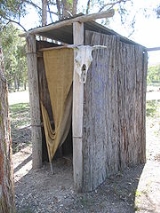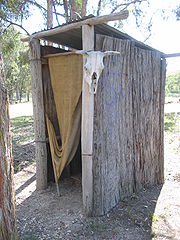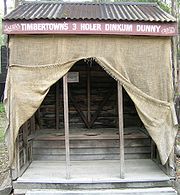
Dunny
Encyclopedia

Toilet
A toilet is a sanitation fixture used primarily for the disposal of human excrement, often found in a small room referred to as a toilet/bathroom/lavatory...
, either the room or the specific fixture, especially an outhouse
Outhouse
An outhouse is a small structure separate from a main building which often contained a simple toilet and may possibly also be used for housing animals and storage.- Terminology :...
or other outdoor toilets. It is often used to specify a distinction between a flushing toilet and a non-flushing toilet (e.g., a longdrop or thunderbox). First used in print in 1952, the word is believed to be derived from the much older 'dunnakin' (also spelled 'dunnigin' and 'dunegan') meaning privy
Outhouse
An outhouse is a small structure separate from a main building which often contained a simple toilet and may possibly also be used for housing animals and storage.- Terminology :...
.
History

Cesspit
A cesspit, or cesspool is a pit, conservancy tank, or covered cistern, which can be used to dispose of urine and feces, and more generally of all sewage and refuse. It is a more antiquated solution than a sewer system. Traditionally, it was a deep cylindrical chamber dug into the earth, having...
. The latter variation can be referred to more specifically as a longdrop. The outhouse would be maintained at some distance from houses for reasons of smell
Odor
An odor or odour is caused by one or more volatilized chemical compounds, generally at a very low concentration, that humans or other animals perceive by the sense of olfaction. Odors are also commonly called scents, which can refer to both pleasant and unpleasant odors...
and hygiene
Hygiene
Hygiene refers to the set of practices perceived by a community to be associated with the preservation of health and healthy living. While in modern medical sciences there is a set of standards of hygiene recommended for different situations, what is considered hygienic or not can vary between...
. The sheds themselves were generally made of either wood
Wood
Wood is a hard, fibrous tissue found in many trees. It has been used for hundreds of thousands of years for both fuel and as a construction material. It is an organic material, a natural composite of cellulose fibers embedded in a matrix of lignin which resists compression...
or corrugated iron, to facilitate the moving of the outhouse if required. In mining areas outhouses are sometimes placed over disused mine shafts.

Plumbing
Plumbing is the system of pipes and drains installed in a building for the distribution of potable drinking water and the removal of waterborne wastes, and the skilled trade of working with pipes, tubing and plumbing fixtures in such systems. A plumber is someone who installs or repairs piping...
diminished the need to keep toilet
Toilet
A toilet is a sanitation fixture used primarily for the disposal of human excrement, often found in a small room referred to as a toilet/bathroom/lavatory...
s at a distance from the house. Nevertheless even some large cities, such as Brisbane
Brisbane
Brisbane is the capital and most populous city in the Australian state of Queensland and the third most populous city in Australia. Brisbane's metropolitan area has a population of over 2 million, and the South East Queensland urban conurbation, centred around Brisbane, encompasses a population of...
, had unsewered suburbs where residences required outhouses into the early 1970s, and they lingered on in Tasmania until the early 1980s.
In built up areas it was unhygienic to rely on cesspits and the usual arrangement was for waste to be collected in a can placed under the dunny. The cans would be collected, emptied, washed and replaced weekly by contractors hired by the local city or town council.
In modern times, many outhouses on old houses remained in use, but have been refitted with modern plumbing and flushing toilets. They are also used in areas too remote to justify the expense of pumping water and sewage piping to, but where there is a need for toilet facilities, such as at remote campsite
Campsite
A campsite or camping pitch is a place used for overnight stay in the outdoors. In British English a campsite is an area, usually divided into a number of pitches, where people can camp overnight using tents or camper vans or caravans; this British English use of the word is synonymous with the...
s or along walking tracks. Farmers and station
Station (Australian agriculture)
Station is the term for a large Australian landholding used for livestock production. It corresponds to the North American term ranch or South American estancia...
owners sometimes also construct outhouses at remote but often used yards or sheds.
The Great Australian Dunny Race has become an icon during the Weerama Festival at Werribee.

